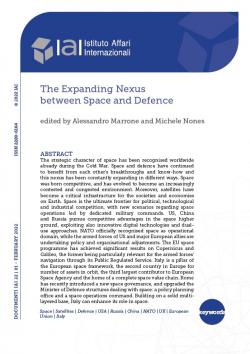The Expanding Nexus between Space and Defence
Lo spazio è l’ultima frontiera non solo per la competizione tecnologico-industriale, di intelligence e politica tra grandi potenze, ma per innovazioni che aprono nuovi scenari di operazioni spaziali condotte da appositi comandi militari. L’Ue investe in importanti costellazioni di satelliti per l’osservazione terrestre e la navigazione satellitare quali Copernicus e Galileo, che vanno protetti, mentre la Nato ha riconosciuto lo spazio come nuovo dominio operativo. La competizione tecnologica è sempre più trasversale: Stati Uniti, Cina e Russia perseguono il vantaggio competitivo nell’higher ground spaziale, nell’innovazione e nell’utilizzo di approcci duali che incorporano anche novità digitali. L’Italia quale secondo Paese europeo per assetti in orbita e terzo per investimenti nel settore, dotata di un apposito Comando per le operazioni spaziali e di un’industria competitiva e all’avanguardia, può e deve giocare un ruolo maggiore in questo settore strategico.
-
Dati bibliografici
Roma, IAI, febbraio 2022, 109 p. -
In:
-
Numero
22|01
Executive summary, by Alessandro Marrone and Michele Nones
The strategic character of space
The new US military approach to space
Russia and China: West’s systemic rivals on orbits
NATO and its members: a space Alliance?
The new UK military approach to space
The European way to space: what strategic evolution?
The technology dimension and duality
Italy and space, a strong position to enhance
1. The new US military approach to space, by Karolina Muti
1.1 Evolution of the US military architecture for space domain integration
1.2 Space strategies: Trump and Biden
1.3 Military space doctrines and capabilities
1.4 Space sustainability, non-proliferation and arms control
1.5 Cooperation and partnerships
2. Russia and China: West’s systemic rivals on orbits, by Giancarlo La Rocca
2.1 Relaunching a global space power legacy: Russia’s approach to space
2.2 Space as continuation of politics with other means: The rise of China to the orbits’ elite
2.3 The Eastern approach to space: A vicious circle
3. NATO and its members: A space Alliance?, by Elio Calcagno
3.1 A new NATO Operational Domain
3.2 Berlin’s timid approach
3.3 France’s right to “active” defence
3.4 A Space Alliance?
4. The new UK military approach to space, by Elio Calcagno
4.1 The Brexit conundrum
4.2 A doctrine for space power and space control
4.3 The role of the private sector
4.4 A peculiar trajectory
5. The European way to space: What strategic evolution?, by Giancarlo La Rocca
5.1 A responsible actor, not a naïve power
5.2 Taking stock of the EU evolving approach to space, security and defence
6. Italy and space, a strong position to enhance, by Giancarlo La Rocca and Alessandro Marrone
6.1 Italy’s stellar track record
6.2 Crafting a whole-of-government approach
6.3 The military reorganisation and the Space Operations Command
6.4 Space in the Quirinale Treaty and Franco-Italian cooperation
6.5 A broad industrial landscape
6.6 A strategic set of technological capabilities
7. The technology dimension and duality, by Giancarlo La Rocca
7.1 Innovation and new space
7.2 Dual by nature and by application
7.3 Satellite communication, navigation and EO
7.4 In-Orbit Servicing and Active Debris Removal
8. Conclusions, by Alessandro Marrone and Michele Nones
8.1 Space: more strategic, competitive, congested and contested than ever
8.2 US, NATO, and a wake-up call for Europe and Italy
8.3 Ten recommendations for Italy
8.4 Space, the ultimate frontier
List of acronyms
Tema
Tag
Contenuti collegati
-
Pubblicazione22/02/2022
Spazio e difesa: un legame crescente. Executive summary
leggi tutto -
Evento11/02/2022
Lo spazio nei conflitti, i conflitti nello spazio
leggi tutto




